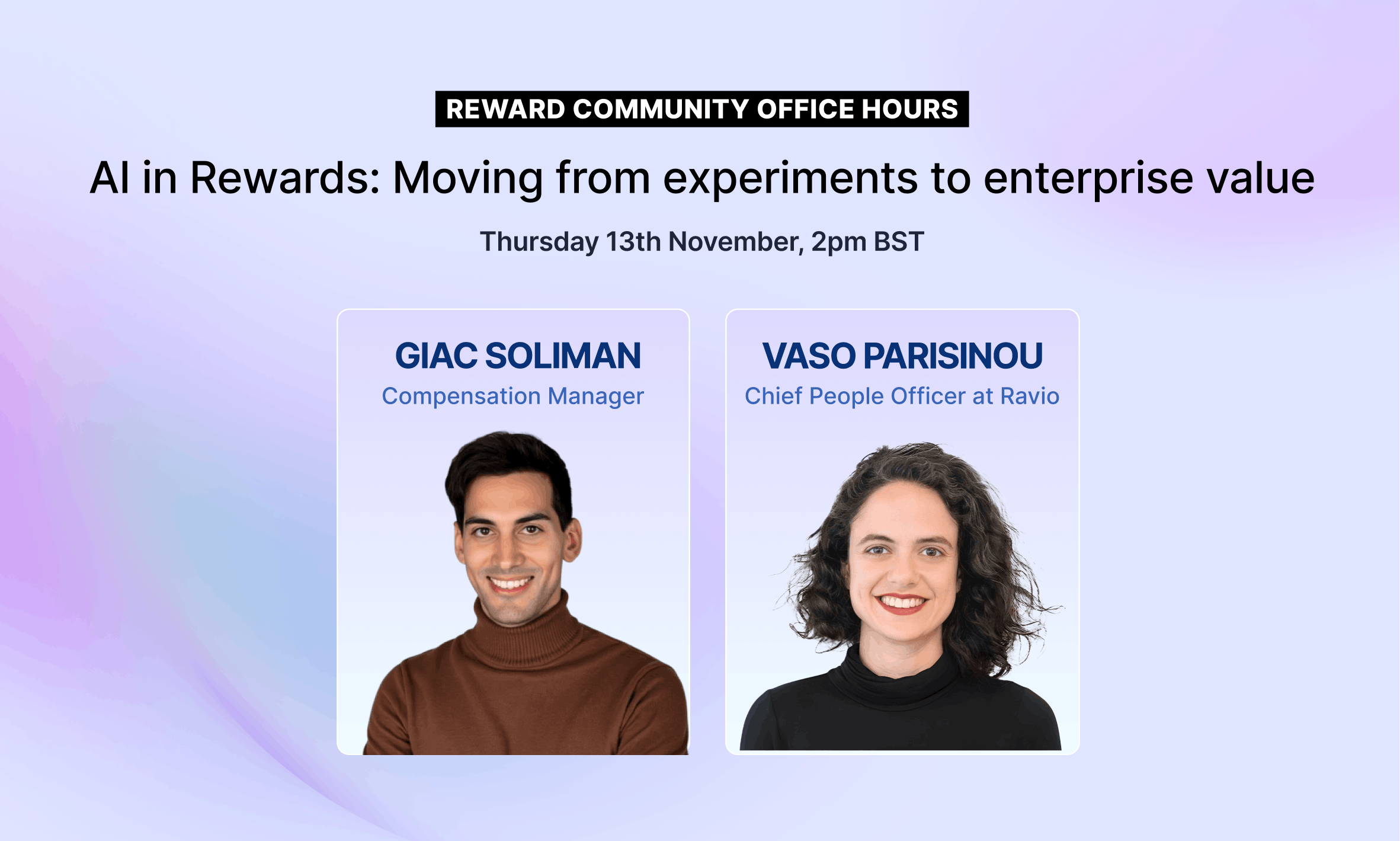Job evaluation is a core component of effective compensation management.
Done right, it ensures that the relative impact and value of each role in a company is understood – the first step to fair and consistent job levels, career progression pathways, and compensation decisions.
Done wrong, a faulty approach to job evaluation will lead to inconsistencies in compensation and progression decisions, ultimately causing pay equity issues and damage employee trust.
But the job evaluation process can be very complex.
Should you use point factor, factor comparison, or another method entirely to assess roles? How many job levels should you have in your org structure? How can you avoid bias when assigning employees to the agreed job levels?
Plus, it can take weeks of manual work, and there’s rarely enough time carved out for the People Team to really nail it.
Which is where job evaluation software comes in – these tools can make it much quicker and easier to implement a structured and best practice framework for job levels.
So, we’ve scoured the market to find the 8 best job evaluation software options in 2024, and we’ve included their pros and cons, standout features, pricing options, and user reviews, to help you make an informed decision.
💡 The 8 best job evaluation software options
- Ravio
- Gradar
- Zellis
- Mercer IPE
- Korn Ferry Architect
- Croner
- Easygrading
- Paygrade by Paydata
What features should you look for in job evaluation software?
There are a few key features to keep an eye out for when you’re evaluating different options for job evaluation software:
- Explanation of the provider’s job evaluation approach. There are many different approaches and methods that can be used for evaluating and levelling roles. It’s crucial that the provider you choose is open and transparent about how their approach works. This helps you ensure it aligns with industry best practice and will work for your company’s needs – as well as making it easy for you to find and reference in any internal conversations about job level decisions.
- Manual adjustments. There may be scenarios in which your company structure doesn’t quite align with the job evaluation approach and decision that the software provider uses. A manual adjustments feature means that you can make small tweaks to the job evaluation to ensure it entirely fits your needs.
- Employee-by-employee job level view. Once you’ve completed the job evaluation and have the company level framework ready-to-go, it can be useful if the software is then able to map your existing employees onto the new level framework. This gives a great starting point for other vital People processes such as pay equity analysis, performance reviews, etc.
- Data security. If you’re inputting employee data or integrating your HRIS with the job evaluation software then it’s important the provider has strong security credentials. Any trustworthy provider should openly offer information about their privacy and security standards – which ideally should include SOC 2 certification.
- Additional compensation management features. Job evaluation is only the starting point for compensation management. Tools which offer job evaluation as well as other compensation management features (like benchmarking data, salary band set up, pay equity analysis, etc) are likely to be more cost efficient, as well as avoiding the need to switch between software constantly.
1. Ravio
Ravio is a compensation management platform powered by reliable and real-time benchmarking data.
Every company that joins Ravio goes through a job evaluation process as part of onboarding. The company’s employees are mapped to the Ravio level framework – which is designed to be universal for any company size and to reflect industry best practice for job levels and career progression.
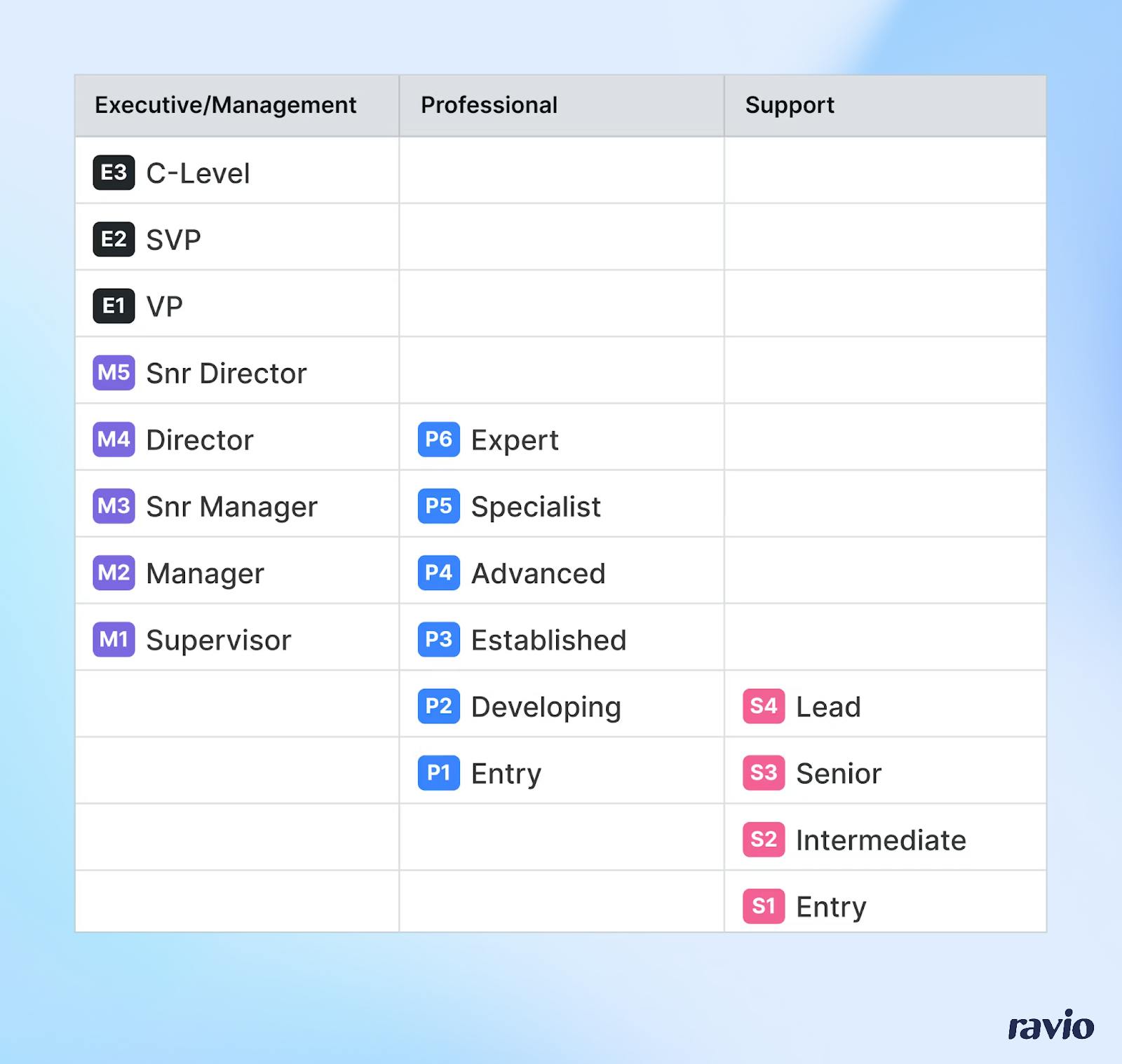
Ravio's levelling framework
This effectively means that when you join Ravio, job evaluation and levelling is done for you to a best-in-class standard, at no additional cost.
There are two scenarios here, depending on where your company is at:
- For those with no job evaluation process or levelling framework in place, the Ravio team evaluates each of your employees one-by-one and assigns them the correct level within the Ravio level framework – so you have a ready-made level framework for your own company.
- For those with an existing level framework, you will receive a bespoke correlation table to show you exactly how your company levels (and therefore individual employees) have been mapped to Ravio's levelling framework.
Manual adjustments to the levelling framework or to the job level of any individual employee can be made at any time within your Ravio account.
Plus, Ravio also integrates with your HRIS, which means that if an employee’s job role changes or they go up a job level at promotion, this will be automatically updated in Ravio.
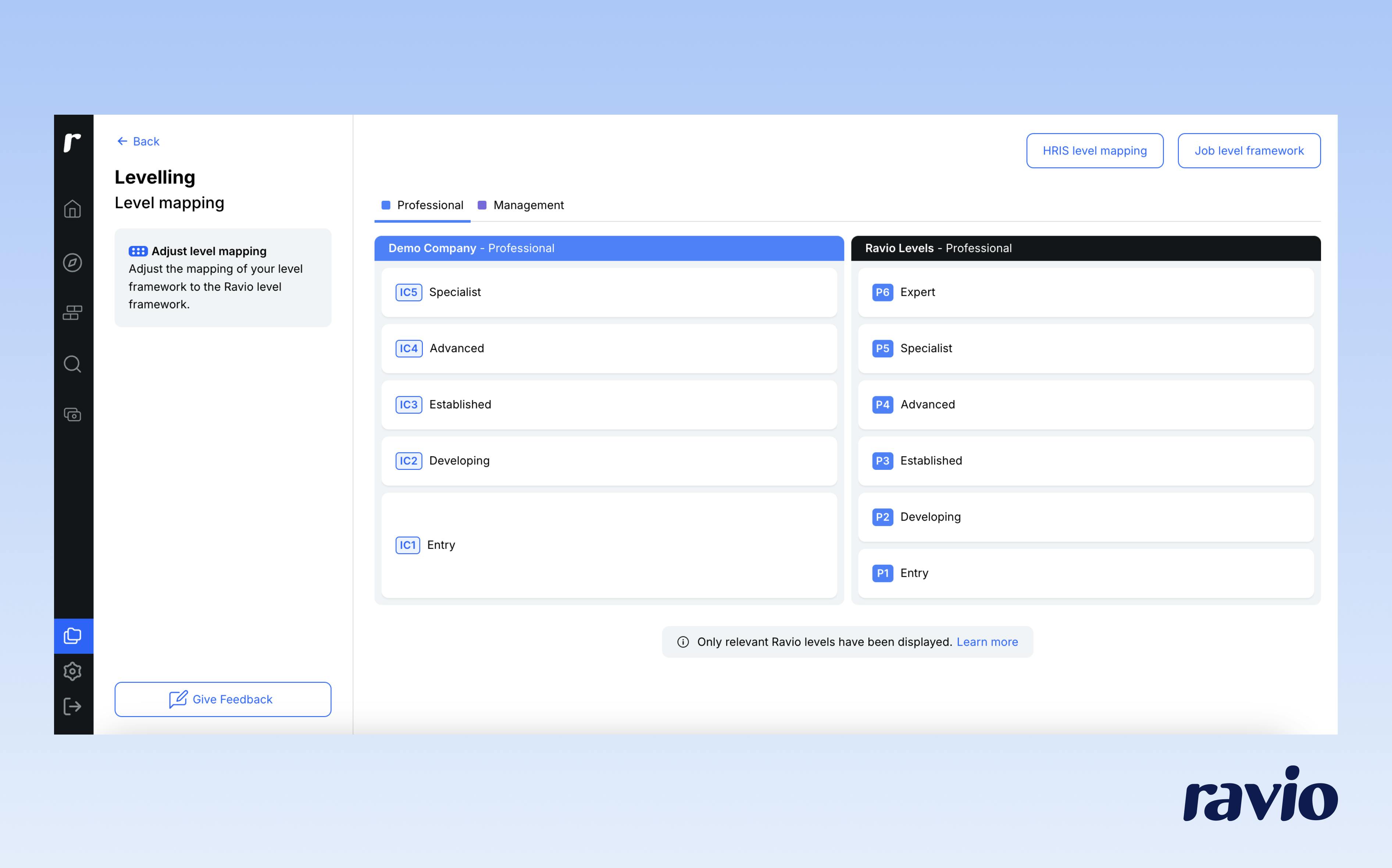
Ravio job evaluation pros
- Levelling done for you: The job evaluation process is taken off your plate as the first step when you join Ravio, with a ready-made structure and all employees accurately mapped to that structure.
- Easily adopt a best practice approach: A logical and consistent structure with clear definitions for each job role and level is key to a strong job evaluation, and with our best practice approach you can feel confident that this is in hand.
- Maintain the flexibility to make changes: Enjoy the ability to make manual adjustments to the correlation table and to the job evaluation for individual employees.
- Employee job changes are automatically reflected in your account: When you connect your HRIS to Ravio we automatically update your account with any changes to employee job roles or levels, so that your job evaluation doesn’t go out-of-date.
- Ravio supports you with so much more than just job evaluation: Job evaluation is a vital foundation for consistent and fair compensation decisions, but it’s only the starting point – once it’s in place you then need to use it to inform all of the other elements of your compensation strategy: from benchmarking to salary bands to pay equity analysis and more.
Ravio job evaluation cons
- Comprehensive compensation management solution. If you’re simply looking for a software solution to support you with a job evaluation process, and nothing more, then you might find a more lightweight tool a better option to get started with. Job evaluation in Ravio is the first step of an end-to-end compensation management platform.
Ravio pricing
The pricing for Ravio varies based on the number of employees in your organisation and the modules that you need access to (e.g. benchmarking vs salary bands vs pay equity). As a rough estimate, pricing for a 100 person company starts at around £5,000 per year.
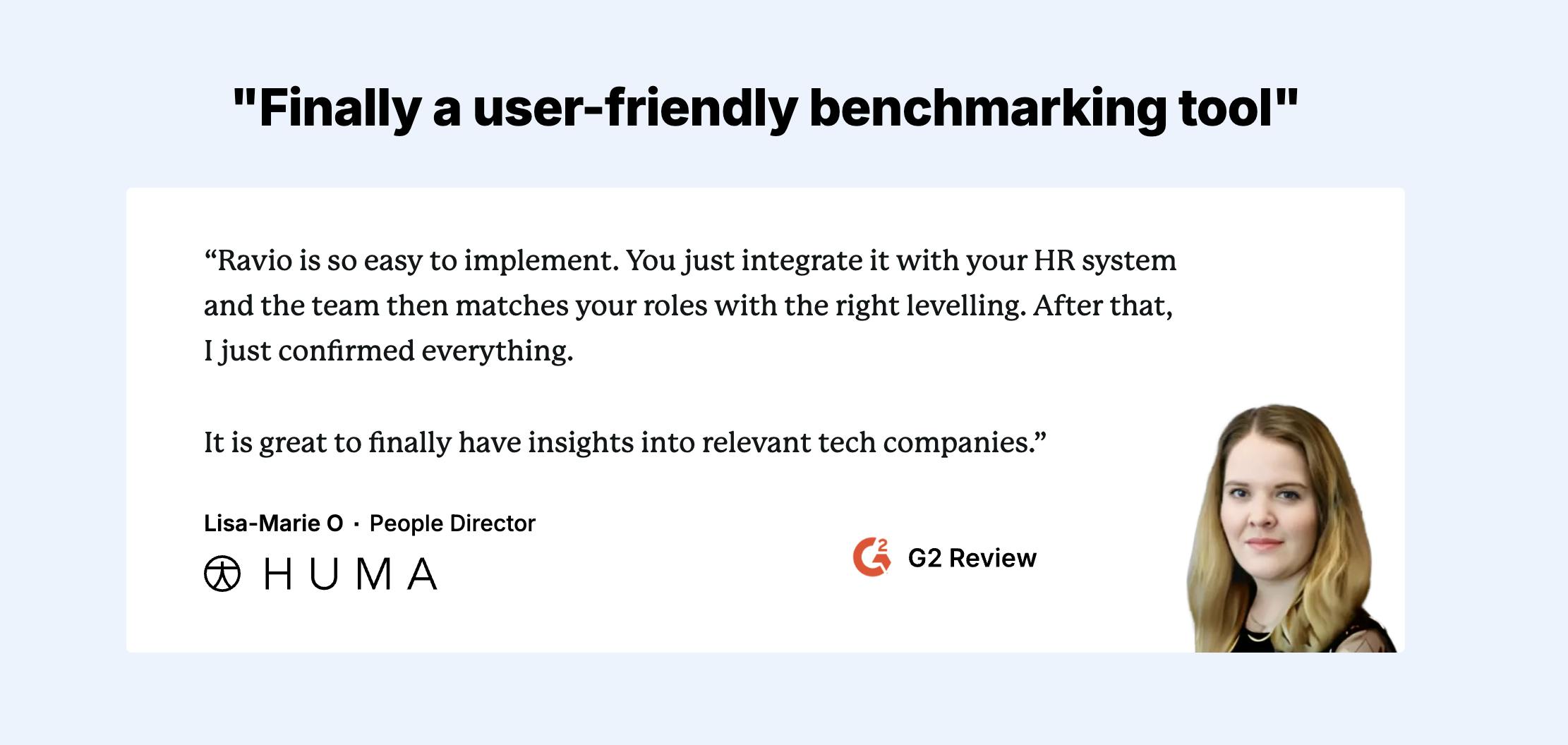
2. Gradar
Gradar is a tool for managing job architecture and evaluation.
With Gradar you can automatically evaluate job roles and levels within your company against the Gradar job evaluation methodology to build a ready-made company structure with consistent job levels and clear career pathways for all roles.
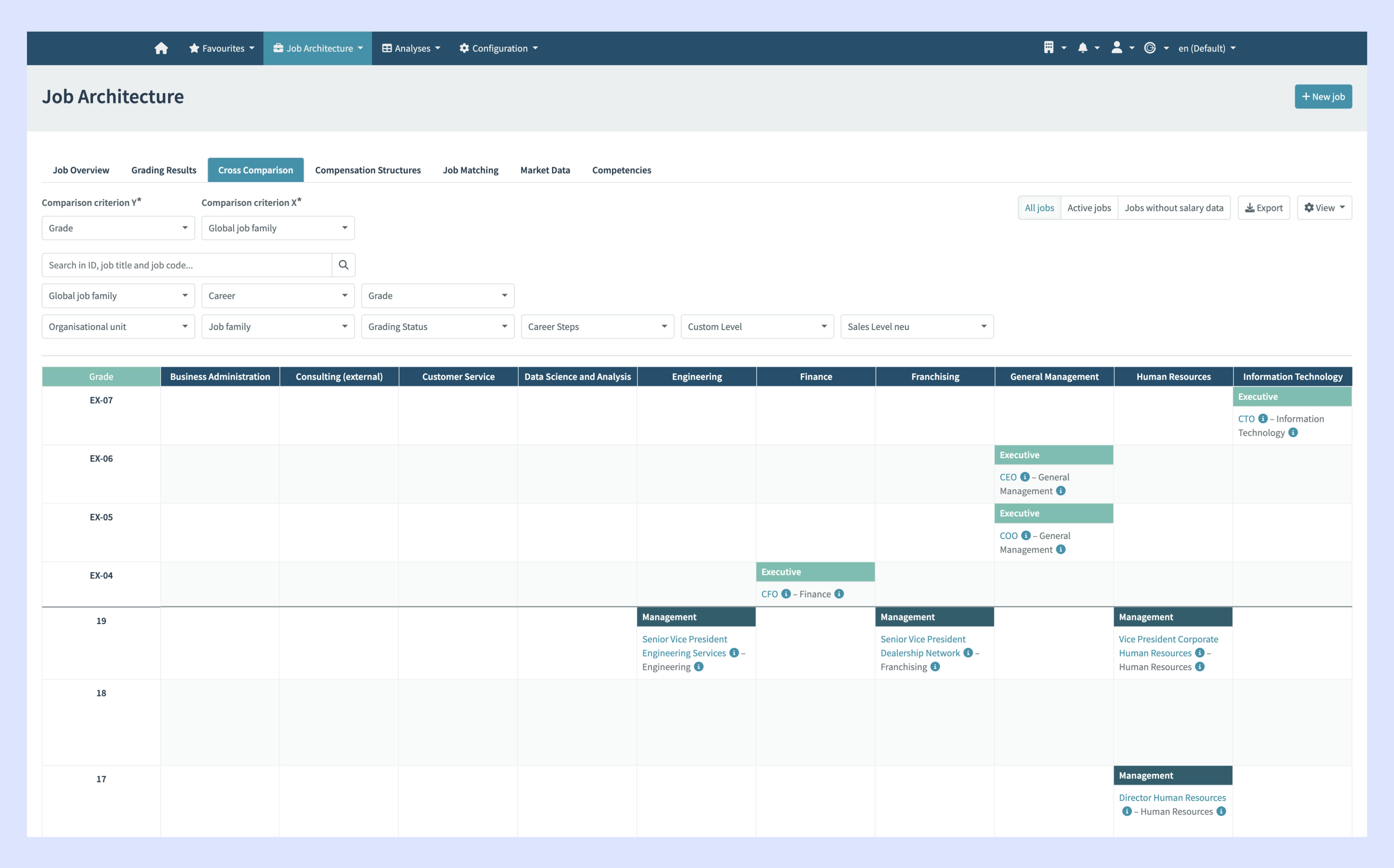
Gradar's job architecture
Gradar uses a point-based factor method to evaluate roles, wherein the responsibilities and impact of a job role are evaluated using a set of standardised factors.
Gradar uses many factors to evaluate roles – with the factors used varying depending on the career track the role falls into (individual contributor, manager, project manager). The image below shows which factors are used with each career track:
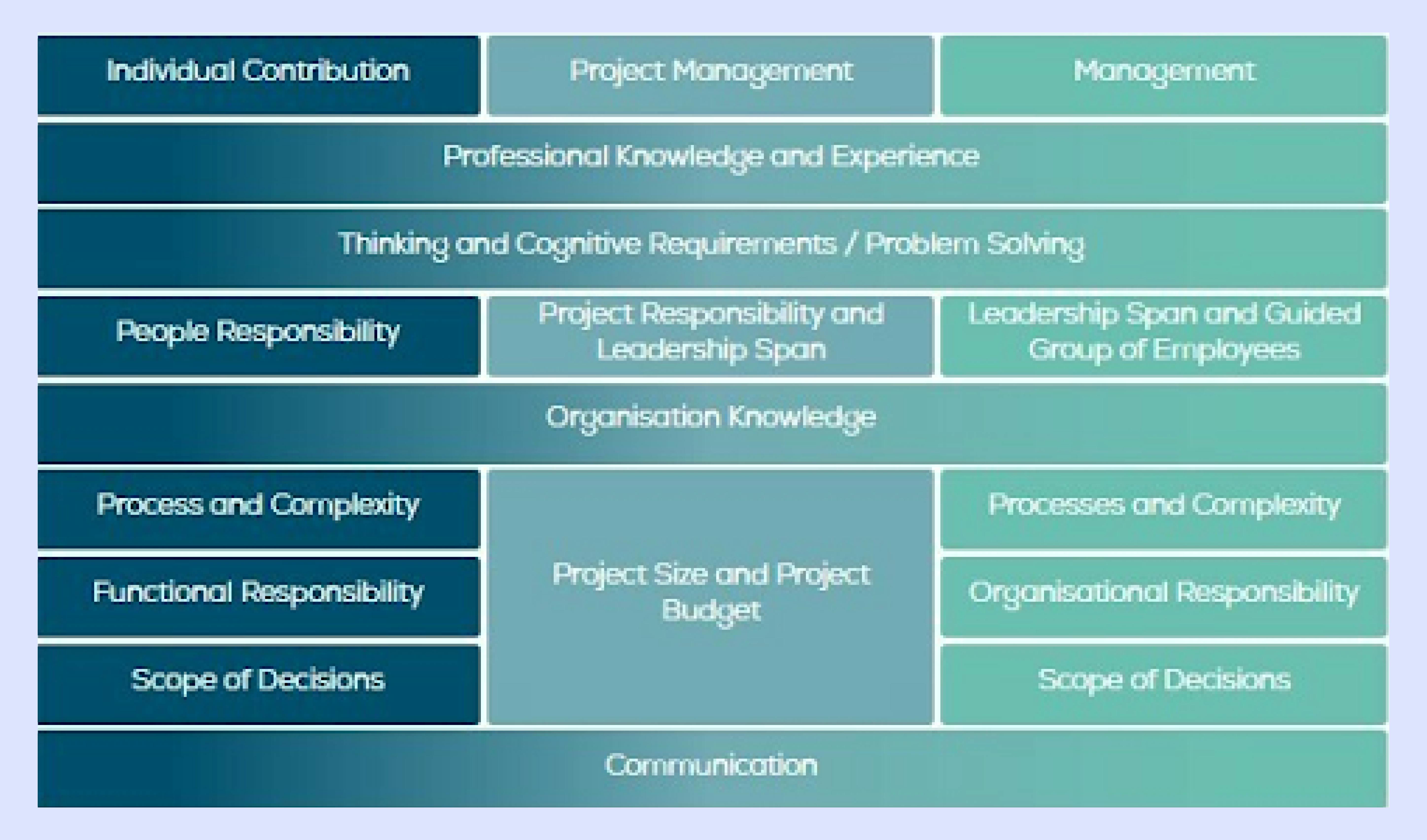
Gradar's factors in each career track
If you choose to upload employee data, you can also then map existing employees to the job architecture that Gradar has created for you.
Plus, you can also upload market benchmarking data from your salary benchmarking data provider or purchase data within Gradar from third-party providers like Culpepper so that you can analyse pay equity across job levels for your employees.
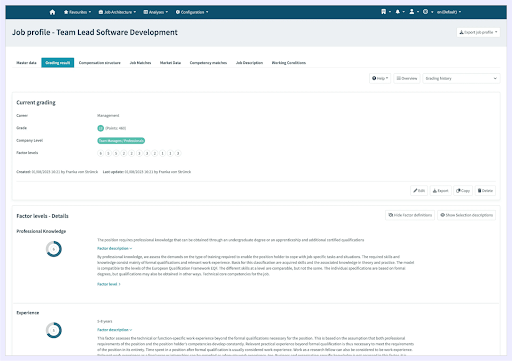
Gradar's job profile page
Gradar also offers additional features, such as generating AI-powered job descriptions to use when hiring for a new job position.
Gradar job evaluation pros:
- User-friendly software. Job evaluation and levelling processes have traditionally been completed via complex spreadsheets. Gradar’s software solution makes the process simpler and easier to visualise. Gradar reviewers reference the software’s strong UX, intuitiveness, and ease-of-use.
- Excellent customer support. Gradar’s team of job evaluation and compensation experts are on hand to support when using the tool. Gradar reviewers reference the excellent guidance and support of the customer support team.
Gradar job evaluation cons:
- Complex level framework. Gradar’s job architecture structure uses 25 levels or grades in total. Adopting a level framework with this large number of levels can cause a lack of differentiation between the levels, leading to confusion and inconsistency when it comes to compensation and progression decisions.
- Non-traditional career track i.e. Project Management. Gradar’s job architecture structure has three career tracks: Individual Contractor (IC), Management, and Project Management. IC and Management career tracks are industry-standard, but Project Management is not typically separated into its own career track. This may make it more complex to align existing practices with the Gradar structure – though this may also be an advantage if your company is very reliant on project management roles.
- The point factor method is susceptible to bias. The point factor method is intended to bring a quantitative approach to job evaluation. However, there is inherent subjectivity when deciding the factors used to evaluate job roles and the weighting assigned to each factor (i.e. the points scored) which introduces bias and can skew the job evaluation.
- The point factor method can be rigid. The point factor method can also be a very inflexible approach wherein only quantifiable factors are assessed, potentially meaning that other valuable qualities are not captured during the job evaluation.
- Third-party benchmarking data. Whilst Gradar does offer a salary benchmarking feature, it does not own and manage that data itself which reduces the reliability and functionality. Instead, users have two options. Firstly, you could upload benchmarking data from another provider into the Gradar platform. Secondly, you could purchase salary benchmarking datasets from Gradar as a third-party reseller from legacy salary survey providers like Culpepper.
💡 Will you need to use the point factor method to comply with the EU Pay Transparency Directive?
The question has been raised recently in the HR and People community of whether it will become compulsory to use a point factor method for job evaluation and levelling to stay compliant when the EU Pay Transparency Directive becomes law across EU countries.
This isn’t the case.
The EU Pay Transparency Directive brings two major areas of change with relation to job levels:
- Employee pay transparency. Employees will have the right to request information on the pay of colleagues at the same job level as them, as well as information on the criteria used for career and pay progression. It will also be mandatory to include the salary band in the job advert for any new roles, meaning that employees will also have access to information on new hire salaries.
- Gender pay gap reporting. Companies will be required to report on their gender pay gap across several segments, including how the gender pay gap differs across the lower, middle, and upper pay band quartiles (i.e. across job levels). Companies must have a pay gap lower than 5% across all segments – or must be able to justify differences in pay with objective reasoning.
These changes do mean that companies will need to have a robust job architecture and level framework in place to ensure that employees can easily understand the rationale behind pay at different levels and to inform the explanation and elimination of pay gaps.
Some organisations are interpreting this to mean that companies must adopt a point factor method for objectivity in their approach to job levels.
However, there is no requirement within the EU Pay Transparency Directive to use the point factor method.
EU member states are currently in the process of transposing the Directive into national laws so we may see some changes in the legislation from country to country – but it’s highly unlikely that any country will be as prescriptive as to mandate the approach that companies should use for job evaluation and levelling.
Plus, the point factor method for job evaluation can actually result in a less objective and robust job architecture and levelling framework than other methods. This is because there is inherent bias in the choosing of the factors used to evaluate roles and the relative weighting of each factor.
Gradar reviews
Gradar has a G2 rating of 4.5 out of 5.
Current customers of Gradar include Sparks (Automotive Engineering, Germany), BirdLife International (NGO, UK), and DKV Mobility (Payments, Germany).
Gradar pricing
Gradar has three pricing packages which range from £2,700 to £8,100 per year:
- Starter package at £2,700 per year – 2 users, job grading for 75 roles
- Professional package at £5,400 per year – 4 users + unlimited read-only users, job grading for unlimited roles
- Enterprise package at £8,100 per year – 8 users + unlimited read-only users, job grading for unlimited roles.
3. Zellis
Zellis is an HR platform which includes a job evaluation scheme called ‘Zellis Universal’ – alongside many other features e.g. payroll management, employee onboarding, employee recognition, and much more.
The Zellis job evaluation software uses a point factor method to automatically evaluate each of the roles in your organisation against five factors: responsibility, knowledge, reasoning, communication, environment. This gives you the starting point to develop a consistent and fair levelling framework and ensure fair and competitive compensation practices.
Zellis job evaluation pros:
- One provider for many HR needs. Alongside the job evaluation software, Zellis also provides many other tools and consultancy services for HR and People teams e.g. payroll management, total rewards planning, employee recognition schemes. It could be beneficial to have a single provider to manage costs and avoid switching between platforms constantly.
- Record justifications in-platform. Users always have access to the end-to-end job evaluation approach in their account to ensure transparency. There is also the ability to record the justification for any choices made regarding the relative impact of each role within the platform so that this information is documented and available to all users.
Zellis job evaluation cons:
- The point factor method is susceptible to bias. The point factor method is intended to bring a quantitative approach to job evaluation. However, there is inherent subjectivity when deciding the factors used to evaluate job roles and the weighting assigned to each factor (i.e. the points scored) which introduces bias and can skew the job evaluation.
- The point factor method can be rigid. The point factor method can also be a very inflexible approach wherein only quantifiable factors are assessed, potentially meaning that other valuable qualities are not captured during the job evaluation.
- Public sector focus. Zellis has a specific focus on job evaluation and job grading for the public sector in the UK. Public sector and civil service organisations tend to have a job grading system which differs significantly from private companies and startups, so this is an important consideration when deciding on your job evaluation software provider.
- UK and Ireland focus. Zellis specifically works with companies based in the UK and Ireland. If your company is based outside of these locations, Zellis will not be a suitable provider.
- Broad HR software provider. Zellis provides a broad range of tools and consultancy services for HR and People teams alongside their job evaluation software e.g. payroll management, total rewards planning, employee recognition schemes. This may mean that they lack in-depth expertise on compensation and job levelling as a specific area of knowledge.
Zellis reviews
Zellis has a G2 rating of 4.2 out of 5 and a score of 1.7 out of 5 on Trustpilot.
Current customers of Zellis include the NHS and the Greater London Provincial Council (GLPC).
Zellis pricing
Zellis does not currently list any pricing information on their website so you will need to get in touch with the team to find out how much you will need to pay for their services.
4. Mercer IPE
Mercer is a large consultancy which offers a large range of consultancy services for HR teams, from salary benchmarking surveys to pension programmes to talent management strategy development.
Mercer’s offering includes a job evaluation service: the Mercer International Position Evaluation System (IPE). Mercer IPE uses the point factor method, evaluating job roles based on five factors: impact, innovation, knowledge, communication, risk.
Mercer works with you on a project basis, supporting you to implement their IPE methodology to evaluate all roles within your organisation and provide a job architecture structure for your company.
The resulting job architecture structure can be delivered via Mercer’s web-based job evaluation tool. This enables you to visualise, edit, and store job evaluation information. The tool also includes the ability to add users e.g. hiring managers so that they can view and use the job evaluation information too.
Mercer can then also support you as a consultancy partner to use the job architecture structure to inform the development of other processes such as your level framework, career progression framework, or salary bands.
Mercer IPE job evaluation pros:
- Trust and credibility. The large consultancies like Mercer (as well as Radford, Willis Towers Watson, and Korn Ferry) have been supporting corporate HR teams for a long time with processes like job evaluation. They therefore hold a lot of weight and credibility, especially with senior stakeholders, which can make it easier to gain approval on budget and approach.
- Popular salary benchmarking data provider. Many companies already use salary surveys by Mercer (as well as Radford, Willis Towers Watson, and Korn Ferry) for salary benchmarking. It can be beneficial to use the same provider for multiple processes to ensure alignment, as well as to manage costs and minimise supplier compliance and onboarding requirements.
Mercer IPE job evaluation cons:
- The point factor method is susceptible to bias. Mercer IPE uses a point factor method, intended to bring a quantitative approach to job evaluation. However, there is inherent subjectivity when deciding the factors used to evaluate job roles and the weighting assigned to each factor (i.e. the points scored) which introduces bias and can skew the job evaluation. The point factor method can also be a very inflexible approach wherein only quantifiable factors are assessed, potentially meaning that other valuable qualities are not captured during the job evaluation.
- Complex approach. The methodologies used by these traditional consultancy providers tend to be very complex which can make it difficult to interpret and communicate internally – Mercer has a paid training course explaining their IPE methodology. This means it can be difficult to replicate the process again in the future or to make any adjustments in-house which ties you into working with the consultancy each time you want to make a change.
- Expensive. The weight and reputation of the Mercer brand name, and the fact that they work with the world’s largest companies, means users report high rates for projects.
Mercer IPE reviews
As of September 2025, Mercer has a G2 rating of 3.8 out of 5, and a score of 1.5 out of 5 on Trustpilot.
Mercer IPE pricing
Mercer does not currently list any pricing information on their website.
5. Korn Ferry Architect
Korn Ferry is a global consultancy firm which supports companies to improve performance through strategic projects, including HR and People processes.
Today they have software offerings alongside consultancy for some of their core services, through the Korn Ferry Intelligence Cloud. This includes for job evaluation and job architecture design, with the Korn Ferry Architect module.
Korn Ferry Architect is an automated solution which evaluates the value of different roles in your organisation and uses the outcomes to design a job architecture and level framework.
Job roles are assessed against a ready-made job architecture of levelled roles which uses the Korn Ferry / Hay job evaluation methodology. This approach uses a point factor method, assessing job roles against four overarching factors:
- Knowledge: the level of expertise required to perform the job
- Problem-solving: the skills required to overcome common job challenges
- Accountability: the level of influence and decision-making the job requires
- Working conditions: the level physical and/or mental stress caused by the job
The resulting job architecture is editable and customisable to fit any specific needs of your company.
Once roles have been evaluated and a job architecture developed, users can also use Korn Ferry Architect to create a career progression framework and to capture pay grades for each job level within the framework. The overarching Korn Ferry Intelligence Cloud product also has additional modules for other related processes such as salary benchmarking (Korn Ferry Pay) and employee engagement (Korn Ferry listen).
Korn Ferry Architect job evaluation pros:
- Trust and credibility. The large consultancies like Korn Ferry (as well as Mercer, Radford, Willis Towers Watson, etc) have been supporting corporate HR teams for a long time with processes like job evaluation. They therefore hold a lot of weight and credibility, especially with senior stakeholders, which can make it easier to gain approval on budget and approach.
- Well-known and renowned job evaluation methodology. The Korn Ferry / Hay job evaluation methodology is well-established and used by organisations worldwide.
- Popular salary benchmarking data provider. Many companies already use salary surveys by Korn Ferry for salary benchmarking. It can be beneficial to use the same provider for multiple processes to ensure alignment, as well as to manage costs and minimise supplier compliance and onboarding requirements.
Korn Ferry Architect job evaluation cons:
- Specialise in consultancy, not software. If you’re looking for a tool or software solution to automate your job evaluation, then a consultancy like Korn Ferry may not be the right option for you. Whilst Korn Ferry do have software solutions today, tech isn’t their area of expertise.
- Expensive. The weight and reputation of the Korn Ferry brand name, and the fact that they work with the world’s largest companies, means that they can charge extremely high rates for projects.
- Time consuming. Large consultancy providers like Korn Ferry (as well as others such as Mercer, Radford, Willis Towers Watson, Croner, etc.) typically take a long time to complete and deliver a project such as job evaluation – weeks at least, more likely months. They will likely also require a substantial amount of time from your team in order to develop and implement the structure.
- Complex job evaluation methodology. The Korn Ferry / Hay job evaluation methodology is very complex which can make it difficult to interpret and use, as well as to communicate internally to colleagues and employees. The complexity is reflected in the fact that Korn Ferry offers a 2-day paid training course for the methodology which only covers training to evaluate roles up to a mid-level.
- Public sector focus. The Korn Ferry / Hay job evaluation methodology is typically used to evaluate job roles and design job architectures for public sector organisations – councils, universities, healthcare systems e.g. NHS. It may, therefore, be less suitable for private companies.
- The point factor method is susceptible to bias. The point factor method is intended to bring a quantitative approach to job evaluation. However, there is inherent subjectivity when deciding the factors used to evaluate job roles and the weighting assigned to each factor (i.e. the points scored) which introduces bias and can skew the job evaluation.
- The point factor method can be rigid. The point factor method can also be a very inflexible approach wherein only quantifiable factors are assessed, potentially meaning that other valuable qualities are not captured during the job evaluation.
Korn Ferry Architect reviews
Korn Ferry has a G2 rating of 4.2 out of 5.
Korn Ferry Architect pricing
Korn Ferry does not currently list any pricing information on their website for Korn Ferry Architect. Working with large consultancies like Korn Ferry will typically be the most expensive option.
6. Croner
Croner is a consultancy firm which specialises in supporting businesses with employment law, HR, and health and safety.
Whilst they primarily offer support through consultancy projects and advisory services, Croner does have software solutions today for some of their core services – including job evaluation.
Previously Croner’s job evaluation service has been delivered as a consultancy project by Croner’s team of specialists. This is still an option. But, today you can also use the Croner job evaluation software to access their Croner job evaluation results on an online platform, through a subscription. No information is given on how the software works, the features included, or what the platform looks like.
Croner uses a point factor method to evaluate the job roles within an organisation, using 10 factors which include educational standards, responsibility, accountability, complexity, and autonomy. No further detail is given on how the Croner job evaluation methodology works.
Croner job evaluation pros:
- Trust and credibility. The large consultancies like Croner (as well as Mercer, Korn Ferry, Radford, etc) have been supporting corporate HR teams for a long time with processes like job evaluation. They therefore hold a lot of weight and credibility, especially with senior stakeholders, which can make it easier to gain approval on budget and approach.
- Popular salary benchmarking data provider. Many companies already use salary surveys by Croner. It can be beneficial to use the same provider for multiple processes to ensure alignment, as well as to manage costs and minimise supplier compliance and onboarding requirements.
Croner job evaluation cons:
- Specialise in consultancy, not software. If you’re looking for a tool or software solution to automate your job evaluation, then a consultancy like Croner may not be the right option for you. Whilst Croner do have software solutions today, tech isn’t their area of expertise, and this is evident in the lack of information given about how the job evaluation software works.
- Lack of information on the job evaluation methodology. Croner does not provide much insight into how they evaluate job roles, aside from the fact that it’s a point factor method with 10 factors. It’s typical for the methodologies used by these traditional consultancy providers to be very complex, and for them to be implemented through a black box process with little visibility into how the job evaluation has been done. This makes it difficult to use, interpret, and communicate the job evaluation internally.
- Expensive. The weight and reputation of the Croner brand name, and the fact that they work with the world’s largest companies, means that they can charge extremely high rates for projects.
- Time consuming. Large consultancy providers like Croner typically take a long time to complete and deliver a project such as job evaluation – weeks at least, more likely months. They will likely also require a substantial amount of time from your team in order to develop and implement the structure.
- The point factor method is susceptible to bias. The point factor method is intended to bring a quantitative approach to job evaluation. However, there is inherent subjectivity when deciding the factors used to evaluate job roles and the weighting assigned to each factor (i.e. the points scored) which introduces bias and can skew the job evaluation.
- The point factor method can be rigid. The point factor method can also be a very inflexible approach wherein only quantifiable factors are assessed, potentially meaning that other valuable qualities are not captured during the job evaluation.
Croner reviews
Croner has a G2 rating of 3.0 out of 5.
Croner pricing
The pricing given by Croner focuses on packages for 24/7 HR, employment law, and health and safety advice. No pricing information is given specifically for their job evaluation services, either for consultancy projects or for the job evaluation software and so you’d need to reach out to the team for pricing information. It’s typical for large consultancies to be the most expensive option for this kind of process.
7. Easygrading
Easygrading is a job evaluation tool which uses a point factor method to evaluate the job roles in your organisation for you. The result is a score which shows the relative impact of each individual job role, and this information can be used to inform your levelling framework and job architecture. The results can be accessed within the Easygrading software or exported as a PDF.
Easygrading also offers additional features and consultancy services aside from job evaluation, such as total reward strategy development, reward policy development, salary benchmarking, and more.
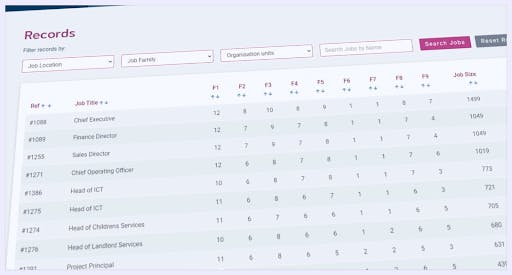
Easygrading job evaluation tool
Easygrading job evaluation pros
- Expert team. Easygrading was founded by HR consultant Bill Roberts, who has extensive experience in job architecture and compensation management. Easygrading has several consultants on the team (including Bill) who are available to support if you’d like to fully outsource the job evaluation process.
- Flexibility with the point factor method. Easygrading’s point factor approach uses a set of 9 core factors to evaluate all job roles. This can be a very rigid approach (see cons). However, they always start by evaluating a sample of job roles and use this to customise the factors used and the weighting given to each factor to ensure it fits your company’s needs.
- Controlled access for collaborators. Easygrading allows you to easily add and delete team members to your account, so that only the relevant people have access to the job evaluation system for each job role. This ensures you can uphold data protection standards and confidentiality.
Easygrading job evaluation cons
- Less well-known provider. Easygrading is a less-well known provider for job evaluation software, which makes it more difficult to evaluate whether they’re the right option for you. Easygrading is also not currently listed on any review site (e.g. G2, Gartner, Capterra, etc) so there is no customer feedback to inform this.
- Limited features. Easygrading is predominantly a rewards consultancy provider who specialise in supporting teams with the design and implementation of best practice rewards processes such as job evaluation, performance management frameworks, employee recognition schemes, etc. The Easygrading job evaluation tool exists to support this by making it easy to view and share job evaluation results, but it doesn’t extend beyond this into other features.
- The point factor method is susceptible to bias. The point factor method is intended to bring a quantitative approach to job evaluation. However, there is inherent subjectivity when deciding the factors used to evaluate job roles and the weighting assigned to each factor (i.e. the points scored) which introduces bias and can skew the job evaluation.
- The point factor method can be rigid. The point factor method can also be a very inflexible approach wherein only quantifiable factors are assessed, potentially meaning that other valuable qualities are not captured during the job evaluation.
Easygrading reviews
Easygrading is not currently listed on any review site.
Current customers of Easygrading include The University of Salford (higher education, UK), Gordon and Macphail (food and beverage, Scotland), and VJ Technology (construction, UK).
Easygrading pricing
Easygrading does not currently list any pricing information on their website, so you will need to get in touch with the team to find out how much you will need to pay for their services.
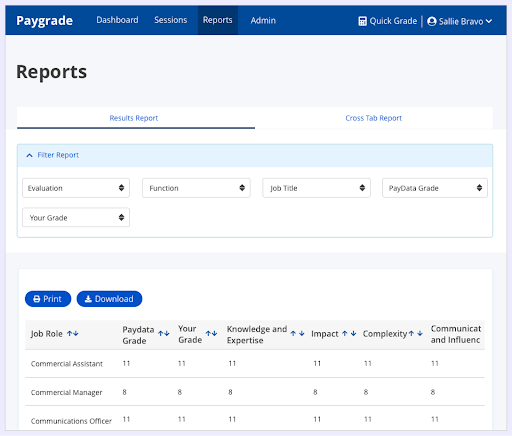
PayGrade job evaluation pros:
- Easy to get started. PayGrade’s job evaluation software is designed to be simple and easy to use. This extends to the job evaluation methodology: there are just five ranking factors so it’s easy to understand – though this can also be a disadvantage (see cons). PayGrade suggests that new customers can be up and running on the software with just a half day training session, compared to typical job evaluation software requiring a week of training.
- Alignment with PayData salary benchmarking data. If you already use PayData’s salary surveys for salary benchmarking then using the PayGrade job evaluation approach can ensure alignment when comparing your company to market data. The PayGrade job evaluation outcome can also be mapped to other salary survey providers.
PayGrade job evaluation cons:
- Less well-known provider. Easygrading is a less-well known provider for job evaluation software, which makes it more difficult to evaluate whether they’re the right option for you. Easygrading is also not currently listed on any review site (e.g. G2, Gartner, Capterra, etc) so there is no customer feedback to inform this.
- Limited features. A role-by-role job evaluation is the only function of the Paygrade software, it does not extend to building your level framework or planning salary ranges for each role and level identified. This may be an advantage for some companies, but for others it may be more valuable to use a broader compensation management tool which brings all compensation processes and structures together in one place.
- The point factor method is susceptible to bias. The point factor method is intended to bring a quantitative approach to job evaluation. However, there is inherent subjectivity when deciding the factors used to evaluate job roles and the weighting assigned to each factor (i.e. the points scored) which introduces bias and can skew the job evaluation.
- The point factor method can be rigid. The point factor method can also be a very inflexible approach wherein only quantifiable factors are assessed, potentially meaning that other valuable qualities are not captured during the job evaluation.
PayGrade reviews
PayGrade is not currently listed on any review site.
PayGrade pricing
PayGrade does not currently list any pricing information on their website.

